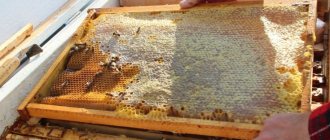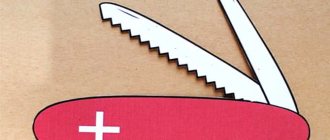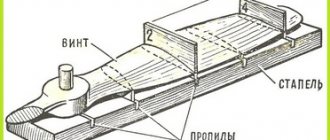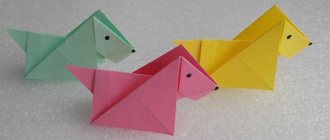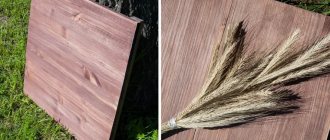Karambit is a short knife with a curved blade. It has a sharpening on the inside and a special shape of the handle with a special ring for the index finger. As a rule, this weapon is taken with a reverse grip, which is most convenient for carrying out ripping movements. Due to its unusual shape, this knife is very popular not only among bladed weapon lovers and collectors, but also among gamers who will not confuse it with any other knife. How to make karambit with your own hands?
How to make karambit
In this article you will see pictures and drawings of a karambit knife, and also learn about the process of making a model from scrap materials.
The knife has a curved blade with a sharpening on the inside and a handle with a ring for the index finger.
A reverse grip is predominantly used, intended for ripping movements. Thanks to its unusual shape, karambit attracts the attention of ordinary people and bladed weapon lovers, and avid gamers will immediately recognize this remarkable knife. You can make it yourself, according to drawings, at home.
Tiger Claw
“CS:GO” is a popular computer toy for boys of all ages, over 13-14 years old. Its plot is primitive, but the arsenal used by the heroes amazes the imagination with its vastness. From bladed weapons to firearms, everything is used to complete a rather controversial mission. Among the knives included in the KS-ki collection, as gamers briefly call the toy, the most notable knife is the karambit. It is shaped like a tiger's claw - just as curved and causing the same lacerations. On the handle of the knife there is a round hole for a finger - for a better grip, and also to show off such a weapon, turning it with all sorts of somersaults. You can buy almost real karambit by ordering it in one of the online stores. Or you might wonder how to make karambit from wood with your own hands and find a solution.
Karambit knife: what kind of knife is it
Karambit differs from other knives in that it has a curved blade and sharpening on the inside.
The length of the karambit blade can be different - from five to nine centimeters. The key feature of this knife is the small ring on the handle, which is designed to make it more comfortable to hold the weapon in your hand and prevent it from slipping in the palm. The historical homeland of the karambit knife is the island of Sumatra. Local warriors of the Minangkabau tribe used such weapons in wars with other tribes.
A karambit knife can be bought in a specialized store, or you can make it yourself, both a real knife, made of metal, and a decorative karambit - made of paper, cardboard or wood. If you have not found a ready-made kit for making karambit, then for a future craft you will need to find a drawing of a karambit knife.
Artistic creativity
It’s not enough to know how to make a karambit from wood; you also need to paint it so that it looks like the real thing. There are several options for coloring (skins) of a knife in the game Counter-Strike: Global Offensive: from “Clear Water” to “Murder”. There are professional artists who, for a fee, manually paint models of karambits to look like real ones.
But you can try to paint your own karambit yourself. It is best to use acrylic paints - they mix well, are harmless, dry quickly and do not get dirty. The skin can be viewed on the CS:GO website, or you can come up with it yourself. The main thing is to turn on your imagination and desire to make a beautiful thing that looks like a real Tiger Claw knife. Good luck!
The history of knives dates back to the times when man first mastered the processing of materials. The first specimen was made of stone, although it is very difficult to call it a normal knife; it looked more like a scraper. Then metal casting was mastered, and the weapon began to take on a form closer to the modern one. A knife is an almost universal tool that can be used both for peaceful purposes, for example, for cooking, creating clothes and other products, and for military purposes - to resolve various kinds of conflicts.
From the history
This unique weapon has a rich history. The earliest mentions of karambit date back to the 12th century. But it is impossible to know the true history; it is shrouded in legends.
According to one of them, in parts of Indonesia, the local people had a cult of the tiger. People considered him a formidable jungle dweller. They thought that when they died, the souls of their kings transmigrated into the tiger. And the local population began to make combat knives, copying the appearance of a tiger claw. According to other versions, the blade originated either from the demon Bima, whose main weapon was claws, or from the king of the monkeys, who had a magical claw in his palm.
Most likely, the actual prototype of the blade was an ordinary sickle, and the hole was a necessity so that the object would not accidentally fall out of the hand. In these areas, the most common work was in the rice fields - in the water.
In ancient times, it was common on the Indonesian islands to smear the blade with strong poison. As a result of a small, lacerated wound, the enemy died instantly.
Along with heavy types of karambits, there were small ones - for domestic needs and self-defense.
The blade was made like this:
- carbon steel;
- the handle was made of wood or from the horn of an animal;
- the scabbard was made of wood, decorated, but did not have pendants; the blade was intended to be worn in the belt.
Karambit became the prototype of the Bulang blades, which were tied to the legs of roosters in cockfights.
Versions of occurrence
There are several different versions of the origin of “karambits”. It is worth noting that none of them can be accepted as 100% true.
The first version says that “karambit” is a kind of derivative of a tool that was used in agriculture by the people of Malaysia. To put it simply, according to this version, the product is based on an agricultural sickle, which was used for harvesting rice fields. In favor of this version, a certain parallel can be drawn between a modern knife and a combat sickle called “kama,” which was popular in the territory of modern Japan.
The second hypothesis says that the karambit knife was used during the formation of the Malaysian archipelago for cockfighting. To give greater dynamics and drive, small knives were tied to the paws of the fighting birds, which had a curved shape, reminiscent of a cock’s spur. Based on this, there are two translation options for the word “karambit” itself: “cock spur” and “rooster tail feather.”
There is a third version, which says that a military weapon was originally created, and its ancestor was a certain brass knuckle knife equipped with special claws. This device was widespread in the territory of modern India.
Buy or make?
At the moment, you can find knives for every taste and budget; you can come across drawings of a knife made of plywood and plastic for those who are committed to making believable dummies. However, you can purchase a low-quality fake, even if you ordered a decorative version. There is nothing more reliable than an item made by the owner himself.
How to repair kitchen knives
Very often the handle of a favorite item breaks. Don’t rush to throw away your convenient blade; take some time to repair it.
Find a small piece of moisture-resistant plywood large enough to make the handle. Two fragments measuring 18x3x1 cm will do.
Also stock up on self-tapping screws, liquid nails glue, a file, emery cloth, varnish or paint:
- An original handle for a knife made from plywood with your own hands will be ideal if you initially make a template of the blank from paper or cardboard.
- Transfer the outline to the plywood dies, tracing the template with a pencil. You should end up with two identical wooden halves.
Marking the handle mounting points.
- The blanks are cut out and applied to the blade. Don't forget to mark where the screws will fit.
- To prevent the plywood knife from falling apart in your hand, the inside of the dies is smeared with glue, then a “sandwich” is assembled from the halves and the blade.
- The fitted parts are fastened with self-tapping screws and clamped in a vice for about a day. You can put the semi-finished product under a heavy press.
- After the glue has completely dried, the handle is finished with a file and emery cloth.
The photo shows the finished pen.
- In relation to household knives, the instructions advise covering the finished product with waterproof varnish or painting.
Note! Instead of fastening with self-tapping screws, you can rivet the handle. But the method is not available to everyone and is not so reliable. Threaded screws are held tighter, their heads are recessed and cleaned.
Legal assistant
Among the knives allowed by law to be worn and not considered edged weapons (with a blade length of up to 9 centimeters), there are also quite original and useful specimens. They have an affordable price and interesting appearance. For example, this is the “butterfly” of Filipino origin (the original name is “balisong”), the Malaysian-Indonesian knife “karambit” and the Nepalese “khukri”.
The last two have a strongly curved claw-shaped blade; the handle is often equipped with brass knuckles. The butterfly got its name thanks to the handle that extends in both directions, in which the blade is hidden when folded. When the arms open, they resemble wings.
Making at home
Many people, after purchasing karambit, decide to try making it themselves. As practice shows, this is not always as simple as it might seem at first glance, although many succeed. In order to create a karambit knife with your own hands, you must have at least basic knowledge in the field of metal processing, as well as have the appropriate tool and material. There are several options for making karambit.
The first method is to use a blade from a pendulum saw as a blank. As a rule, steel grade R6M5 is used in such construction tools. The essence of the method is that you need to cut a blade of a certain shape from a workpiece using a grinder or an emery wheel. For accuracy, a “karambit” knife pattern is used. When using this method, there is no need to use heat treatment, but it is worth remembering that the main thing is not to overheat the product during the manufacturing process. To achieve the desired result, you definitely need an exact drawing of a “karambit” knife; only then will an almost perfect copy be obtained.
A more complex method is to make a knife from a spring. As a rule, in this case, steel 5160 is used. In order to obtain the desired product, the spring is drilled along the contour of the future knife, then using a bench tool it is given its original shape. For knives that are made in this way, further heat treatment is necessary. The blade needs to be hardened and tempered. If necessary, this can be done on a home gas stove.
The best option for making your favorite knife is to buy a ready-made kit, which is designed to create a tool. This usually includes an excellent blade, a small piece of wood for the future handle, and a piece of leather or other material to create a sheath. Such kits are mainly supplied by the Norwegian company Helle.
The forged blank consists of three layers of alloy steel. This material is great for making knives. If you use a set, the work is much less. This is a great way to bring your metal imagination to life. You can make a karambit knife with your own hands of excellent quality, but at the same time it will have a unique design. Much depends on your imagination. To simplify the task, you can find a ready-made drawing of a “karambit” knife and use it to make your own version.
How to make karambit from wood
The manufacturing scheme is simple: you need to find a suitable drawing - there are quite a few of them due to the wide variety of models. In addition, you need to sensibly evaluate your ability to work with wood or plywood. Then complete the blanks and fasten them.
The work is simple, but differs in a number of nuances.
- A drawing of karambit made of wood is transferred to cardboard or paper - this is how templates are obtained. Their number depends on the complexity of the model. In the simplest case, you will need 3 parts: the main part of the dagger - the blade and handle, and two figured attachments that provide a recognizable karambit relief.
- The templates are outlined with a pencil and cut out with a jigsaw or cutter. The latter takes quite a long time. The photo shows cutting with a jigsaw.
- The hole in the handle is cut with a feather drill. If you don’t have such a device, you can do the work with a jigsaw. To do this, pierce a through hole with an awl, then insert a file into the hole, attach it to a jigsaw and cut out the hole.
- The parts cut out according to the drawing are smeared with PVA glue and glued together. The structure is placed in a vice or clamped with a clamp until the glue dries completely - usually a day.
- Then the product is cleaned with sandpaper or a sander. The knife should be completely smooth. If there is a desire to make it more durable, then the workpiece is impregnated with bakelite glue.
- If the product is used in a role-playing game, it is painted as in the picture.
Price
The price of a karambit knife may vary due to several factors: the manufacturer, manufacturing technology and the material from which the blade was made.
On average, the minimum price is from 35 to 40 dollars - these are small folding knives. For $450-500 you can purchase high-tech branded products. Sometimes the price of a blade directly depends on the company, namely on the brand, on how it is promoted. In this case, you should not be surprised if two almost identical knives, but only from different manufacturers, have different prices.
Origin
Karambit comes from Sumatra, one of the Asian islands, where it was compared to a tiger's claw.
Indeed, the external resemblance of the blade is easily traced, and the blows inflicted by the weapon resemble the swings of the paw of an angry animal.
Its historical origin is still unclear. There are two main options. The first is that it was used in cockfights, tied as spurs so that the rooster would injure its opponent.
The second was a formidable hunting and combat knife of warriors from Malaysia. None of the options have been proven. The photo below shows what the prototype of a modern karambit looks like.
Operating technique
The karambit knife is a personal weapon. In terms of its size and diameter, the ring must correspond as closely as possible to the anatomical characteristics of the owner.
"Karambit" can be used as a main and secondary weapon. It is often used in a paired arrangement. Having one knife, a fighter must work quite actively with his free hand to perform a variety of grabs, blocks and strikes. Therefore, you should carefully familiarize yourself with the design features of the weapon in order to take this into account in battle.
Since the karambit knife is used only at fairly close distances, how a person moves during combat is very important. Today there are two main grips - forward and reverse, as well as their varieties. Where can I buy a karambit knife? How much does such a product cost? It all depends on the execution technique and the type of metal from which the weapon is made.
Drawing of karambit made of plywood
One of the most popular materials for making a karambit knife is plywood.
A plywood knife, of course, is not a real weapon, but it can be used in martial arts to practice techniques with weapons; the same weapon can also be used in role-playing games based on fantasy works, which are so popular among modern youth. Drawings for a karambit knife made of plywood can be the same as drawings for a knife made of metal. You just need to find a sketch of the blade and modify it to fit the finished dimensions. You can easily download drawings of a karambit knife from specific websites about weapons - there you can even find templates that are completely ready for use.
Model assembly
Having cut out all the necessary parts from plywood using a jigsaw, they must be cleaned of dust and degreased. For gluing parts, synthetic glue for wooden surfaces or casein is suitable. It is necessary to use glue strictly according to the instructions so that the model does not fall apart over time. When the karambit has dried thoroughly, a hole for the thumb is drilled or sawed out on the handle. This stage of work should be as careful as possible so that the layout does not break. When everything is ready, the karambit must be sanded with sandpaper and again cleaned of sawdust dust. As you can see, the question of how to make a karambit knife from wood does not have a very complicated answer.
From the history
This unique weapon has a rich history. The earliest mentions of karambit date back to the 12th century. But it is impossible to know the true history; it is shrouded in legends.
According to one of them, in parts of Indonesia, the local people had a cult of the tiger. People considered him a formidable jungle dweller. They thought that when they died, the souls of their kings transmigrated into the tiger. And the local population began to make combat knives, copying the appearance of a tiger claw. According to other versions, the blade originated either from the demon Bima, whose main weapon was claws, or from the king of the monkeys, who had a magical claw in his palm.
Most likely, the actual prototype of the blade was an ordinary sickle, and the hole was a necessity so that the object would not accidentally fall out of the hand. In these areas, the most common work was in the rice fields - in the water.
In ancient times, it was common on the Indonesian islands to smear the blade with strong poison. As a result of a small, lacerated wound, the enemy died instantly.
Along with heavy types of karambits, there were small ones - for domestic needs and self-defense.
The blade was made like this:
- carbon steel;
- the handle was made of wood or from the horn of an animal;
- the scabbard was made of wood, decorated, but did not have pendants; the blade was intended to be worn in the belt.
In video games
In general society, this knife gained popularity due to the Valve game called Counter Strike: Global Offensive. There, karambit is presented as a popular skin for a standard knife, it changes its appearance and animation.
The community immediately liked the skin, but most users did not have enough money for an in-game purchase. Because of this, most of the drawings are made specifically for karambit from cs go.
Here is a screenshot from the computer game CS:GO, which shows what a karambit looks like:
Design features and repairs
Before you make a knife from plywood from scratch, study the characteristics of blade steels. Most likely you will have to order a blank, since it is very difficult to process high-strength alloy yourself. Spring or valve steel is more often used, but the handles can be made of anything, including waterproof plywood.
Wooden butterfly
Butterfly or balisong knives were invented by Filipino fishermen.
They spread throughout the world after World War II, and are still popular today in various fields of application:
- Before you make a butterfly knife from plywood, or rather make handles, carefully study the characteristic features of the product.
- Absolutely symmetrical handle parts are comfortable for both right-handers and left-handers. The knife is considered folding, since the halves of the holder cover the blade when closed.
- There are no springs in the mechanism; the halves are fixed on two hinge axes and a latch.
- In order to make a product from scratch, you will need a drawing of a butterfly knife made of plywood, or a real example as an example.
- When turning the blanks, make sure that when opening the balisong the halves turn 180º. They should rest against the transverse lower pin, fixing the blade well.
Finished plywood butterfly.
- It is worth noting that your plywood butterfly knife can acquire an exclusive appearance and a solid look if you pay special attention to the decoration.
Note! Original carving and careful polishing will give the item an expensive look. Glued plywood after processing has a pattern identical to expensive types of wood, due to stains.
- Waterproof varnish, applied in several layers and allowed to dry, will help to finalize the product.
Karambit knife
The object has a rather frightening appearance, which enhances the effect if the knife is equipped with brass knuckles and teeth on a curved blade. If you don’t know how to make a karambit knife from plywood that is indistinguishable from the real thing, look at the interesting products in the photographs.
You will be surprised not to see two similar models, since there is no limit to the imagination of the masters of their craft:
- Prepare a jigsaw, drill, files and sandpaper.
- It’s good if you ordered or sharpened a high-quality blade in advance. It is easier to adjust the handle to it in terms of design and size.
- For a preliminary sketch, it is better to use ready-made drawings of a karambit knife made of plywood, they are available on the Internet.
- Cut out the drawn blanks with a jigsaw, mark the places for rivets or screws.
- Amateur craftsmen who are confident in their skills can simultaneously make an imitation of brass knuckles. Plywood is not the most durable material, and a menacing appearance is more appropriate here for intimidation than for combat.
- The halves of the handle are glued together and the blade with liquid nails and fastened with self-tapping screws. Next, the product is dried and finished completely.
Note! The Criminal Code of Russia does not consider a knife to be a bladed weapon if the length of the blade does not exceed 90 mm. When engaging in this kind of hobby, take this rule into account, and you will not have problems with law enforcement agencies.
Straight grip
This type of grip is very different from the reverse in that the blade comes out from the side of the thumb, while the little finger is threaded through the ring. People who use the karambit knife in the computer game Counter-Strike are familiar with such techniques. CS GO is a new version of a team shooter that captivates from the first minutes. Here the player can freely use both firearms and bladed weapons, including karambit. Although in real life such a product looks intimidating. It is this kind of “karambit” knife, the photo of which is given below, that is used by gamers in the virtual world.
Basically, a direct grip is used to hold small knives, as well as karambit-like products, which are often used for personal self-defense.
Purposes of creation
The reader may have a reasonable question: is it reasonable in Russia, where carrying knives is illegal, to popularize their creation? Undoubtedly, military weapons should not be made at home. But a wooden knife with a short blade is safe enough so that the most vigilant law enforcement officer will not have any objections.
Why do you need a wooden blade?
There are two main motives for its creation:
- Practicing knife fighting and self-defense techniques without weapons is carried out using blades that most reliably imitate the shape of real ones, but are safer. A plywood karambit will not cause serious damage, even if dropped on it;
- In addition, for the last twenty-five years since the publication of J. R. R. Tolkien’s immortal trilogy in Russia, role-playing games based on fantasy and historical works have been very popular among our compatriots. Obviously, here, too, a reliable but safe imitation of a weapon will come in handy.

